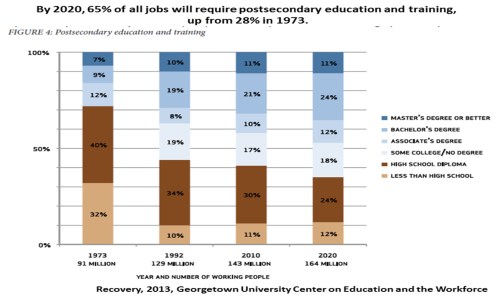I’ve referenced several times the good work that Georgetown University’s Center on Education and the Workforce is doing in predicting the educational preparedness (or lack thereof) of the workforce in relation to the anticipated jobs growth in the United States.
Anthony P. Carnevale and his colleagues have just published Recovery: Job Growth and Education Requirements Through 2020. This is a follow up to their 2010 publication, Help Wanted: Projection of Jobs and Education Requirements Through 2018.
The bad news is that the educational preparedness of the U.S. workforce is getting worse as we look to the future. Without systemic changes to the U.S. post-secondary education system, the economy will now fall 5 million workers short with post-secondary degrees by 2020 – an increase of 2 million from their projection of a 3 million shortfall in 2018.
Job growth numbers are optimistic
While many sources are predicting that the U.S. economy will create 55 million new job openings over the next decade, these new job openings are a combination of an anticipated 24 million newly created jobs and 31 million openings created by Baby Boomer retirements. Foundational to the calculations are that jobs are returning much more slowly that we thought they would following the recession.
Still, an increase of 24 million new jobs between now and 2020 seems hugely optimistic. That’s an average of 307,000 new jobs per month between now and 2020. When has the U.S. sustained that kind of consistent job growth? Well, according to Bureau of Labor Statistics, in the last 30 years, only 1994 averaged new jobs creation at a rate of over 300,000 per month. Yes, 1994 — a long time ago.
So there’s that.
What the talent pipeline will need
But there’s more from this report that’s worth noting for those concerned about the future of the talent pipeline:
- By 2020, 65 percent of all jobs in the economy will require a post-secondary education and training beyond high school.
- 35 percent of the job openings will require at least a bachelor’s degree.
- 30 percent of the job openings will require some college or an associate’s degree.
- 36 percent of the job openings will not require education beyond high school.
 The implications here are clear regardless of the numbers of new jobs created: employers and others predict that soon nearly two-thirds of all jobs will require some kind of post-secondary education or training. In 1973 – just 40 years ago – less than one-third of all jobs required the same.
The implications here are clear regardless of the numbers of new jobs created: employers and others predict that soon nearly two-thirds of all jobs will require some kind of post-secondary education or training. In 1973 – just 40 years ago – less than one-third of all jobs required the same.
Forty years isn’t a very long time – just one generation. Lots of change in the nature of jobs, work, education, skills and employability can happen in 40 years.
The report also defines the skills that will be most valued and in demand for the new jobs landscape. These are not as revolutionary as one might think. Cognitive skills of leadership, communication, analytics and administration will be most valued and in demand. Take a look and see what you think.
The Center on Education and the Workforce generates useful information for those involved with education and/or workforce planning – functions that should joined at the hip today and in the future.
This originally appeared on China Gorman’s blog at ChinaGorman.com.
